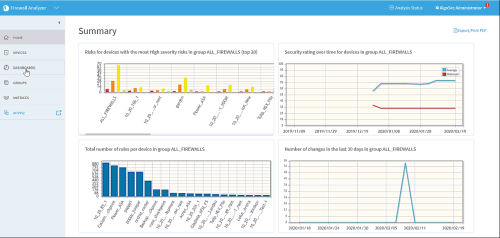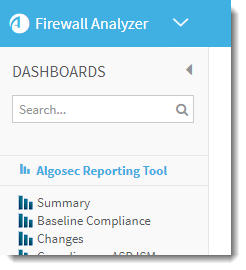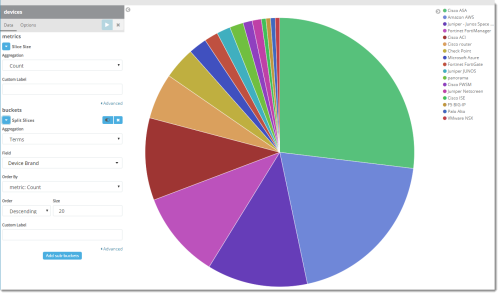AlgoSec Reporting Tool
This topic describes how to use the AlgoSec Reporting Tool (ART), which is an additional AFA reporting tool powered by Kibana.
ART enables you to visualize ASMS data about devices, change requests, and AppViz applications, in a variety of charts, tables, and dashboards.
Note: ART is powered by Kibana version 5.6.16. For more details, see the Kibana resources and documentation.
Click to play the following video, which reviews a few dashboards provided out-of-the-box by AlgoSec.
AlgoSec Reporting Tool prerequisites and permissions
Using ART to create and view advanced dashboards has the following requirements:
| Enable ART operations |
To enable ART for your ASMS system, you must have the ART_Operation_Status parameter set to on in the AFA Administration area. ART starts collecting data only from the date at which this parameter value is defined. If your virtual machines had 4 cores and 16 GB RAM or less and was upgraded, after turning on ART using the parameter above, from within the machine using SSH, send the command: curl -sS -x "" -# 127.0.0.1:8080/afa/UserAliases/allUsersAliases This resets the user permissions for the data in ART and creates the relevant users. |
| User access to ART data |
ART is available only to users who are configured for access. Non-admin users who have access to ART will only see data relevant to their allowed firewalls. For more details, see Manage users and roles in AFA and Manage privileged users. |
Access the AlgoSec Reporting Tool
The AlgoSec Reporting Tool is available from the main menu on the left in AFA or FireFlow, or from several areas in AppViz.
In FireFlow, click  HOME in the main menu on the left. Then, below the options to select a dashboard or create a new one, click the
HOME in the main menu on the left. Then, below the options to select a dashboard or create a new one, click the ![]() AlgoSec Reporting Tool link.
AlgoSec Reporting Tool link.
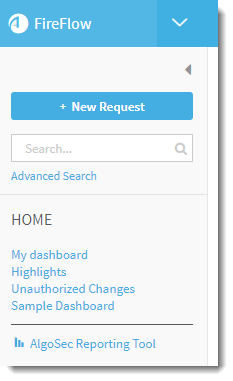
In FireFlow, click CHARTS/DASHBOARDS in the main menu on the left. Then, below the options to select a dashboard or create a new one, click the ![]() AlgoSec Reporting Tool link.
AlgoSec Reporting Tool link.
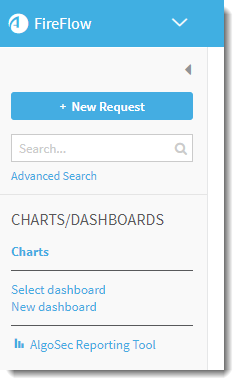
In AppViz, use the main menu on the left to navigate to the HOME, APPLICATIONS, NETWORK OBJECTS, or SERVICE OBJECTS areas. Click the ![]() AlgoSec Reporting Tool link located just below the username menu.
AlgoSec Reporting Tool link located just below the username menu.
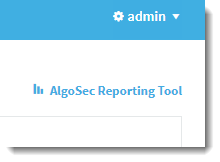
Once in ART, do the following to view data and create charts and dashboards.
Tip: At the bottom-left, click  Collapse to collapse the ART main menu. This provides you with more space to create and manage your data displays. Click the
Collapse to collapse the ART main menu. This provides you with more space to create and manage your data displays. Click the  Expand button to show the menu again.
Expand button to show the menu again.
Discover data
In ART, click Discover to browse ASMS data and create search queries to use in graphs and charts. ART provides a few saved search queries out of the box, and also enables to you create custom searches and filters.
Save your search queries, export them, or share links with others.
Tip: Alternately, start by creating graphs and then add your data. For details, see Visualize a specific field and Visualize data.
Do the following:
- From the main menu on the left, click Discover.
-
At the top-left, click the dropdown to select the type of data you want to view.
applications View data by AppViz application. change_requests View data by FireFlow change requests. devices View data by devices managed by AFA. Tip: Alternately, start with a saved search. Either click Open at the top of the page, or click Management > Saved Objects > Searches.
If you need to, search for the name of your saved search. Click a name to load the saved search.
-
Determine the field data displayed by adding field names to the list of Selected Fields at the top-left.
- In the Available Fields area, hover over the field heading and click Add to add it to the selected fields.
- To remove a field from this list, hover over the field heading in the Selected Fields area and click Remove.
-
Filter the values of the fields displayed to further filter the data shown.
Do the following:
-
Above the data type dropdown, click Add a Filter
 . For example:
. For example: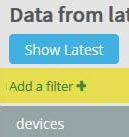
-
In the Add filter dialog, enter a field name, operator, and value.
Note: When selecting the is or is not operator, values must match actual values exactly, and are case-sensitive.
To display a list of actual field values, click a field value header. A bar graph expands to display the sum of each value for the field.
- Click Save to add the selected values to the filter.
The field and value is added to the filter list above the data type dropdown and field lists.
For example:
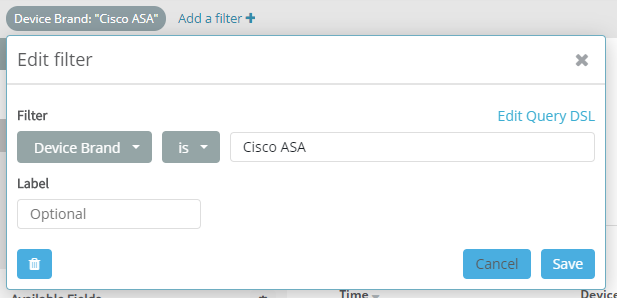
 Filter field options
Filter field options
Once a field is added to the filter, hover over the field in the filter to display further options.

Do any of the following:
 /
/ 
Enable or disable the filter field.
Use this option to keep the filter values defined, but temporarily disable it for the current data displayed.
 /
/ 
Pin or unpin the filter to the top.
Use this option when you have several filters displayed, and you want to select specific filters to view at the top of the list.
 /
/ 
Invert a field definition to show all results that do not match the values selected.
Inverting a field turns the field definition red to indicate that the results shown are negative results.
Click Toggle
 to return to the original field definition.
to return to the original field definition.
Remove the field from the filter entirely.
This removes your field values, and you'll need to define them from scratch if you need them again.

Edit the field values selected.
In the Edit filter dialog, update the selected filter name, operator, and value, and then click Save.
Tip: At the far right, click Actions q to display these same actions for all filters defined.
 Advanced query editing
Advanced query editing
ART provides the following advanced filter editing features for experienced Kibana or Elastisearch users.
-
In the search bar at the top of the screen, enter a query syntax manually to define the field names and values for your filter.
Click Show Latest to automatically add the Current:true field and filter out all historical data from the data displayed.
For more details about query syntax, click the Uses lucene query syntax link at the right of the search box.
- In the Edit filter dialog, click Edit Query DSL to manually update or copy in an Elastisearch Query DSL to use for this field value definition.
-
-
At the top of the page, click any of the following to manage the filtered data:
New Discard all of your changes and start a new filter from scratch. Save Save your filter so that you or other users can return to it later on.
Click Open to view a list of saved searches.
Share Display links to either share a saved search or a snapshot.
Tip: Full link URLs may be long. Click Copy to copy the full URL to the clipboard, or Short URL to display a shorter URL that's easier to share.
Date selector Define the date range for the data displayed. For details, see Change date ranges.
Continue with creating graphs and dashboards. For details, see Visualize a specific field, Visualize data, and Create or edit dashboards.
Jump directly from the Discover section of ART to Visualize in order to create graphs based on a specific filter field.
Do the following:
-
Hover over any filter name in the Selected or Available Fields list to display a bar chart of the values for that field.
For example:
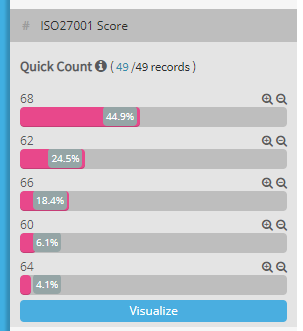
- Click Visualize to display the selected field in the Visualize area.
For more details, see Visualize data.
Visualize data
In ART, click Visualize to start by creating or loading graphs and charts and then adding or modifying the data used.
Export, share, or embed your visualizations in other locations, or add them to ART dashboards. For more details, see Create or edit dashboards.
Tip: Alternately, start by browsing data and then use that data to create graphs. For details, see Discover data.
Do the following:
-
Click Visualize from the main menu on the left.
A list of saved visualizations is displayed.
Tip: Alternately, click Visualize from a specific field dropdown in the Discover area. For more details, see Visualize a specific field.
- Click the name of a saved search to display a chart based on that data.
-
Click
-
Click the name of a saved visualization to view, or click
 Create new visualization to create a new one.
Create new visualization to create a new one.If you selected to create a new visualization, do the following:
- Select a chart type to use.
- Select a saved search to use as the data set, or select an index to create a new search. For more details, see Discover data.
-
Once your chart is displayed, define the data metrics and other options for your chart. Click
 to apply your changes.
to apply your changes.Available options depend on the type of chart you're working with. For example:
-
Above the chart display, define a filter to further filter the data shown.
Do the following:
- Above the chart options, click Add a Filter
 .
. -
In the Add filter dialog, enter a field name, operator, and value.
Note: When selecting the is or is not operator, values must match actual values exactly, and are case-sensitive.
- Click Save to add the selected values to the filter.
The field and value is added to the filter list above the data type dropdown and field lists.
For example:

 Filter field options
Filter field options
Once a field is added to the filter, hover over the field in the filter to display further options.

Do any of the following:
 /
/ 
Enable or disable the filter field.
Use this option to keep the filter values defined, but temporarily disable it for the current data displayed.
 /
/ 
Pin or unpin the filter to the top.
Use this option when you have several filters displayed, and you want to select specific filters to view at the top of the list.
 /
/ 
Invert a field definition to show all results that do not match the values selected.
Inverting a field turns the field definition red to indicate that the results shown are negative results.
Click Toggle
 to return to the original field definition.
to return to the original field definition.
Remove the field from the filter entirely.
This removes your field values, and you'll need to define them from scratch if you need them again.

Edit the field values selected.
In the Edit filter dialog, update the selected filter name, operator, and value, and then click Save.
Tip: At the far right, click Actions q to display these same actions for all filters defined.
 Advanced query editing
Advanced query editing
ART provides the following advanced filter editing features for experienced Kibana or Elastisearch users.
-
In the search bar at the top of the screen, enter a query syntax manually to define the field names and values for your filter.
Click Show Latest to automatically add the Current:true field and filter out all historical data from the data displayed.
For more details about query syntax, click the Uses lucene query syntax link at the right of the search box.
- In the Edit filter dialog, click Edit Query DSL to manually update or copy in an Elastisearch Query DSL to use for this field value definition.
- Above the chart options, click Add a Filter
-
At the top of the page, click any of the following to manage the chart you created:
Save Save your chart so that you or other users can return to it later on.
Share Display links to either share a saved chart or a snapshot.
Use the Embedded iframe URL to embed this chart in another location.
Tip: Full link URLs may be long. Click Copy to copy the full URL to the clipboard, or Short URL to display a shorter URL that's easier to share.
Refresh Refresh the chart currently displayed with updated data from AFA, FireFlow, or AppViz. Date selector Define the date range for the data displayed. For details, see Change date ranges.
Continue by creating dashboards that include your charts. For details, see Visualize a specific field, Visualize data, and Create or edit dashboards.
Filter fields by data type
Each data type provides a different set of fields for discovering and visualizing data in ART.
For details, see:
The following filter fields are available for AppViz application data in the Discover and Visualize areas. For more details, see Discover data and Visualize data
|
Field |
Description |
|---|---|
|
Application ID |
The AppViz application ID. |
|
Change requests.Id |
A change request ID number. |
|
Change requests.Opened date |
The date that a change request was created. |
|
Change requests.Requestor |
The requestors of a change request, separated by commas. |
|
Change requests.Status |
The status of a change request. |
|
Connectivity status |
The connectivity status for an application's flows. |
|
Created |
The date an application was created. |
|
Critical process |
The name of a critical process. |
|
Current |
Determines whether historical data is filtered out.
|
|
High risks |
Defines whether risks are defined as High. |
|
Labels |
The labels assigned to an application. |
|
Lifecycle phase |
Defines the application's lifecycle phase:
|
|
Name |
The name of an application. |
|
Number of blocked flows |
The total number of blocked traffic flows. |
|
Number of flows |
The total number of traffic flows. |
|
Number of unscanned servers |
The number of unscanned servers. |
|
Part of critical process |
Defines whether an application is part of a critical process. |
|
Pci application |
Defines whether an application assigned to the PCI system label. |
|
Projects.Name |
The name of a project that an application is managed by. |
|
Projects.Status |
The status of a project. |
|
Relevant devices |
The devices associated with an application. |
|
Revision ID |
The revision ID of an application. |
|
Revision status |
The revision status of an application. |
|
Risk score |
The application's risk score. |
|
Vulnerabilities.CVSS |
A server severity CVSS score. |
|
Vulnerabilities.Title |
A risk item title. |
|
Vulnerability score |
A vulnerability score. |
|
_id |
An application ID. |
|
_index |
An application index. |
|
_score |
An application score. |
|
_type |
A filter category. |
The following filter fields are available for FireFlow change request data in the Discover and Visualize areas. For more details, see Discover data and Visualize data.
|
Field |
Description |
|---|---|
|
Created |
The date a change request was created. |
|
Current |
Determines whether historical data is filtered out.
|
|
DaysOpen |
The number of days a change request has been open. |
|
Devices.AFA_Group |
The name of an AlgoSec Firewall Analyzer device group. |
|
Devices.Brand |
Device brands. |
|
Devices.Id |
Device IDs. |
|
Devices.Name |
Device names. |
|
Expiration |
A change request expiration date. |
|
Id |
A change request ID. |
|
InStatusSince |
The date from which a change request has been in its current status. |
|
Owner.Name |
The name of a change request's owner. |
|
Owner.Roles |
The role of a change request's owner. |
|
PreviousStatus |
A change request's prior status. |
|
RequestType |
A change request type. |
|
Requestor.Email |
The email address of a requestor. |
|
Requestor.Name |
The name of a requestor. |
|
ResponsibleRoles |
The responsible roles of a requestor. |
|
Status |
A current change request status. |
|
Subject |
A change request subject. |
|
TemplateName |
The name of a change request's template. |
|
WorkFlow |
The name of the workflow that controls a change request's lifecycle. |
|
_id |
A change request ID. |
|
_index |
A change request index. |
|
_score |
A change request score. |
|
_type |
A filter category. |
The following filter fields are available for AFA device data in the Discover and Visualize areas. For more details, see Discover data and Visualize data
|
Field |
Description |
|---|---|
|
ASD_ISM Level |
An ASD_ISM score level. |
|
ASD_ISM Score |
The lowest ASD_ISM compliance score. |
|
BASEL Level |
A BASEL score level. |
|
BASEL Score |
The lowest BASEL compliance score |
|
Baseline Compliance Level |
A Baseline Compliance level. |
|
Baseline Compliance score |
The lowest Baseline Compliance score. |
|
Current |
Determines whether historical data is filtered out.
|
|
Device Brand |
A brand name. |
|
Device Groups |
A device group. |
|
Device IP |
A device IP. |
|
Device Id |
A device ID. |
|
Device Name |
A device name. |
|
GDPR Level |
A GDPR score level. |
|
GDPR Score |
The lowest GDPR compliance score. |
|
GLBA Level |
A GLBA score level. |
|
GLBA Score |
The lowest GLBA compliance score. |
|
HIPAA Level |
A HIPAA score level. |
|
HIPAA Score |
The lowest HIPAA compliance score. |
|
Highest Risk Level |
The highest risk score level. |
|
ISO27001 Level |
The IS027001 score level. |
|
ISO27001 Score |
The lowest IS027001 compliance score. |
|
NERC Level |
A NERC score level. |
|
NERC Score |
The lowest NERC compliance score. |
|
NIST_800-171 Level |
A NIST 800-171 score level. |
|
NIST_800-171 Score |
The lowest NIST 800-171 compliance score. |
|
NIST_800-41 Level |
A NIST 800-41 score level. |
|
NIST_800-41 Score |
The lowest NIST 800-41 compliance score. |
|
NIST_800-53 Level |
A NIST 800-53 score level. |
|
NIST_800-53 Score |
The lowest NIST 800-53 compliance score. |
|
Number of Baseline Compliance changes |
The number of Baseline Compliance changes. |
|
Number of Covered Rules |
The number of Covered Rules. |
|
Number of Disabled Rules |
The number of Disabled Rules. |
|
Number of Duplicate Objects |
The number of Duplicate Objects. |
|
Number of High Risks |
The number of High Risks. |
|
Number of Low Risks |
The number of Low Risks. |
|
Number of Medium Risks |
The number of Medium Risks. |
|
Number of Special Case Rules |
The number of Special Case Rules. |
|
Number of Suspected High Risks |
The number of Suspected High Risks. |
|
Number of Unused Rules |
The number of Unused Rules. |
|
PCI Level |
A PCI score level. |
|
PCI Score |
The lowest PCI compliance score. |
|
Report Date |
A Report Date. |
|
Report Name |
A Report Name. |
|
Rule Count |
A Rule Count. |
|
SOX Level |
A SOX score level. |
|
SOX Score |
The lowest SOX compliance score. |
|
Security Rating Score |
A Security Rating Score. |
|
TRM Level |
A TRM score level. |
|
TRM Score |
The lowest TRM compliance score. |
|
_id |
A device ID. |
|
_index |
A device's index. |
|
_score |
A device score. |
|
_type |
A filter category. |
Create or edit dashboards
ART dashboards consist of graphs, or visualizations created in the Visualize area. In addition to the default dashboards that AFA provides out of the box, create or customize your own dashboards to suit your needs.
Do the following:
-
Click Dashboard from the main menu on the left. ART displays a list of saved dashboards.
Search for the dashboard you want to view, or click
 Create new dashboard to create a new one.
Create new dashboard to create a new one. -
Do one of the following:
Add new dashboard If you are creating a new dashboard from scratch, click Add to add saved graphs and charts to your dashboard.
Click a visualization name to add it to the dashboard draft below. Scroll down to view your dashboard graphs and charts.
Edit saved dashboard If you are editing a saved dashboard, click Edit at the top of the page to modify the graphs and charts on the selected dashboard.
-
Each dashboard widget has the following options shown at the top right:
-
 . Expand the selected widget to full-screen size.
. Expand the selected widget to full-screen size. -
 . Open the selected chart or graph in the Visualize area for editing. For details, see Visualize data.
. Open the selected chart or graph in the Visualize area for editing. For details, see Visualize data. -
 . Move the selected widget to a different location in the dashboard.
. Move the selected widget to a different location in the dashboard. -
 . Remove the selected widget from the dashboard.
. Remove the selected widget from the dashboard.
To resize a widget, hover over the widget and use the
 corner icon shown at the bottom right to drag the widget edges to the new size.
corner icon shown at the bottom right to drag the widget edges to the new size. Display advanced dashboard widget details
Display advanced dashboard widget details
Click the
 arrow at the bottom left of a widget to display the following:
arrow at the bottom left of a widget to display the following:Table Display the widget data in table form, or export the data.
- Below the table, click Raw or Formatted to export your data.
- From the Page Size drop down, select an option to determine the number of table rows to display.
Request Display the Elasticsearch request body. Response Display the Elasticsearch response body. Statistics Display additional statistics about the Elastisearch request performed for this widget. -
-
When you're done customizing your dashboard, click Save and enter a name and description for your dashboard.
Tip: Optionally, select Store time with dashboard to update the global date range to the date range currently selected, when you edited the dashboard.
Click Cancel at the top of the page to exit the editing mode and discard your changes.
Note: New custom dashboards created are added to the end of the list of saved dashboards. To find yours, either scroll down the list completely, or enter the dashboard name in the search field.
Dashboard options
Use the following additional options at the top of the page to manage your dashboard:
| Share |
Display links to either share a saved dahsboard or a snapshot. Use the Embedded iframe URL to embed this chart in another location. Tip: Full link URLs may be long. Click Copy to copy the full URL to the clipboard, or Short URL to display a shorter URL that's easier to share. |
| Clone | Make a copy of the dashboard currently displayed for editing. |
| Export to PDF |
Click to save a PDF with the dashboard data currently displayed. |
| Mail Schedule |
Click to jump in to the AFA Administration area and schedule email updates for the displayed dashboard. For more details, see Schedule dashboard notifications. |
| Date selector | Define the date range for the data displayed. For details, see Change date ranges. |
Change date ranges
All ART pages provide a date range selector, which enables you modify the date range of the data currently shown.

Do any of the following:
- Use the < > arrows to move back and forth between incremental date ranges.
-
Click the selected date range, shown in the center of the < > arrows, to select a more complex date range.
The Time Range area expands, providing you with a series of options of the following types:
Quick Provides quick options, like Today, Previous month, Last 24 hours, or Last 2 years.
Relative Enables you to define date ranges from a specified time ago or from now, to another specified time ago or from now.
Absolute Enables you to select specific start and end dates.
Click Go to update the data displayed based on your date range selections.
For example:

Manage ART objects
The ART Management area enables you to manage saved queries, visualizations, and dashboards.
Warning: The Management area also enables you to configure the Kibana Index and Advanced Settings that control ART functionality.
We recommend keeping the default Index and Advanced Settings to ensure that ART continues to work as expected. For more details, see the Kibana documentation.
Do the following:
-
From the main menu, click Management, and then click Saved objects.
-
Click one of the following tabs:
- Dashboards. Manage saved dashboards. For more details, see Create or edit dashboards.
- Searches. Manage saved searches. For more details, see Discover data.
- Visualizations. Manage saved graphs and charts. For more details, see Visualize data.
-
Do any of the following:
Find your object Browse the list or enter a name in the search field to locate your object. Edit object settings Click an object name in the list to make changes, such as to the object title.
This option also enables you manage advanced settings, such as supporting JSON code.
We recommend making advanced changes like these only if you are an advanced Kibana user.
Open object in ART Hover over the object name, and click the  eye icon to open it Discover, Visualize, or Dashboard areas.
eye icon to open it Discover, Visualize, or Dashboard areas. Delete objects Select one or more objects in the list, and click
 Delete to delete the selected items.
Delete to delete the selected items.In the warning dialog that appears, click Delete ... to confirm the deletion.
Export JSON details Select one or more objects in the list and click
 Export to save the relevant JSON data locally.
Export to save the relevant JSON data locally.To export JSON data for all objects, click Export Everything at the top of the page.
Import objects Create ART objects by importing a JSON file. At the top of the page, click Import and select a JSON file to import.
Troubleshoot ART
If you run into issues when using the AlgoSec Reporting tool, you may want to check the relevant log files.
ART-related logs are created for the Elastic, Kibana, and Logstash services in the /var/log directory on the AFA machine.

